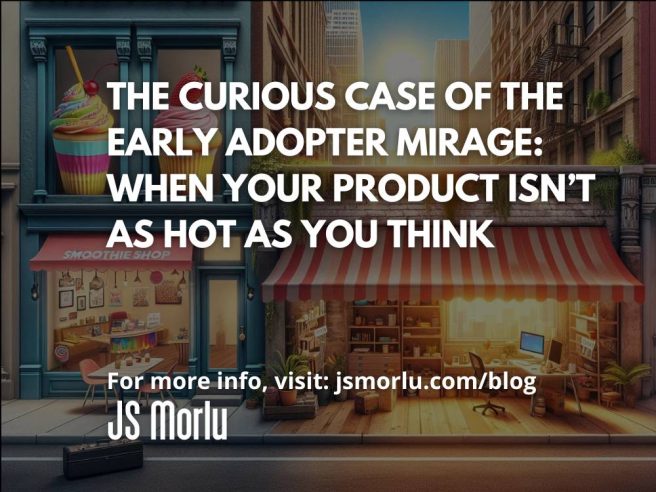By: John S. Morlu II, CPA
Introduction
In a small, sun-bleached office nestled between a vibrant downtown smoothie shop and a charmingly dilapidated cupcake boutique, a startup was born. This wasn’t just any startup; it was the brainchild of three ambitious founders—Sam, Tina, and Clive—who were brimming with the kind of enthusiasm typically seen in fresh MBA grads and caffeine-fueled visionaries. They proudly christened their creation “ZapIt,” a name that conjured images of electrifying innovation and boundless potential. The vision was grand: a revolutionary app designed to make life more ‘frictionless.’ At least, that’s what they told themselves. The truth? No one, not even the founders, really knew what “frictionless” meant in a practical sense. But that didn’t stop them from plowing ahead, intoxicated by the intoxicating shimmer of tech stardom and the tantalizing promise of venture capital dollars.
As the launch day approached, anticipation built like the froth atop a well-blended smoothie. The founders meticulously curated a marketing strategy, engaging social media influencers who promised to create buzz in exchange for the latest gadget. They envisioned a future where ZapIt would disrupt everyday life, transforming mundane tasks into streamlined experiences. In their minds, they were about to join the ranks of tech giants, revolutionizing how people interact with technology and each other.
When they finally went live, users signed up in droves, much like a flock of sheep drawn to a charismatic shepherd. These early adopters were hailed as saviors, the faithful few who saw the future of innovation. The founders watched with gleeful disbelief as their first fifty users registered in what felt like mere moments. Surely, if these early adopters loved it, millions more would soon follow! Or so the logic went.
However, as time would cruelly reveal, early adopters—those elusive beings who roam the tech landscape in search of the next big thing—have a peculiar and often misleading habit of giving entrepreneurs a false sense of success. They thrive on novelty, driven by a hunger for innovation rather than a genuine need for solutions. Their initial enthusiasm can mask deeper issues, blinding founders to the reality that most of the population isn’t interested in the latest digital trinket, no matter how “frictionless” it claims to be. And thus, ZapIt would soon learn this hard lesson, as their gleaming vision began to unravel, exposing the pitfalls that await those dazzled by the early glow of startup glory.
In the world of entrepreneurship, the journey is rarely linear; it is a labyrinth filled with distractions, missteps, and the ever-present risk of delusion. ZapIt’s story serves as a cautionary tale—a comedic reflection on the dangers of misplaced trust in early adopters and a reminder that the true measure of success lies in understanding the market, identifying real needs, and fostering genuine engagement. Join us as we delve into the whirlwind adventure of ZapIt, exploring the trials, tribulations, and lessons learned along the way in a landscape where early adopters reign supreme and clarity is often the first casualty of ambition.

Chapter 1: The Fateful Launch
The founders of ZapIt—Sam, Tina, and Clive—had meticulously planned their launch day as if it were a wedding, complete with color-coordinated spreadsheets, a carefully curated playlist of motivational songs, and even a questionable number of glittery decorations that were just begging to be misplaced. They’d read every blog post on startup success, binge-watched TED Talks until their eyes glazed over, and imbibed inordinate amounts of kombucha, convinced that the fermented tea would somehow infuse their app with the wisdom of Silicon Valley. Clive, the self-appointed CTO and proud owner of an ironic T-shirt that read “Code, Coffee, Repeat,” had even harnessed the power of AI to design their logo—a futuristic lightning bolt that somehow resembled an electrocuted frog. They dubbed it “Froglight,” and it was as confusing as it was memorable.
On the fateful launch day, the atmosphere in the cramped office was electric—pun fully intended. The trio gathered around their laptops, fingers trembling over the keyboard like a group of nervous performers waiting for the curtain to rise. Tina, fueled by a blend of excitement and anxiety, took a deep breath and hit the big, green “launch” button, which they had dubbed the “Button of Destiny.” For a moment, silence engulfed the room. Did the app crash? Was their hard work for naught? But then, like the floodgates of opportunity burst open, users began pouring in. Fifty sign-ups in just an hour! No, wait—sixty! The ticker kept climbing, and Sam nearly fell off his chair in disbelief, his kombucha sloshing dangerously close to his laptop.
Unbeknownst to them, one of these early signups was Craig. Now, Craig was what startup experts call a “Professional Early Adopter”—a rare breed of human who treats new apps like a limited-edition flavor of yogurt. He joins every app or service that hits the market, not out of any genuine interest but for the thrill of being first, as if he were collecting digital Pokémon cards. Craig was the kind of guy who would line up outside an Apple Store for the latest iPhone the night before, only to sell it on eBay the very next day—often for an absurd markup that made you question both his sanity and your own commitment to technology.
Craig and his ilk are the bane of startups. They’ll praise your app on Twitter, raving about it to their five LinkedIn connections like they just discovered the secret to eternal youth. “ZapIt is the future!” they proclaim, their fingers dancing over their keyboards. “I can’t imagine life without it!” And then—poof!—they vanish, leaving behind a digital ghost town where your hopes and dreams used to thrive. This, of course, sends founders like Sam, Tina, and Clive into a euphoric spiral of delusion, convinced they’ve struck gold while their reality is closer to fool’s gold.
As the hours ticked by and the sign-up numbers soared into the stratosphere, Sam and Tina were swept away in a wave of elation. They envisioned venture capitalists knocking on their door, offering to finance their next five apps over extravagant dinners where lobster was served on gold-plated platters. They could already see themselves on magazine covers, grinning alongside profiles of the likes of Elon Musk and Jeff Bezos—except, of course, they’d all be wearing matching “Froglight” T-shirts. Clive, for his part, had begun sketching out designs for “ZapIt” merchandise, including a line of eco-friendly water bottles adorned with their questionable logo.
But as the trio reveled in their newfound success, they remained blissfully unaware of the storm brewing just beneath the surface. Craig, their “Professional Early Adopter,” had a different agenda. He was already strategizing his next digital conquest, eyeing a new meditation app that promised to bring peace and enlightenment—because why settle for one fleeting moment of tech-induced excitement when you can have another?
And so, with Craig leading the charge, the early adopter phase for ZapIt began to resemble a merry-go-round. The founders were on top, twirling in circles, while the reality below was a dizzying descent into confusion and misinterpretation. “Look at all these sign-ups!” Sam exclaimed, grinning ear to ear. “We’re going to disrupt the market!” Meanwhile, Craig had already moved on to his next digital adventure, leaving behind a trail of app store ratings that would make any therapist shudder.
As they basked in their launch-day glory, the trio had yet to grasp the crucial lesson that many startups learn the hard way: early adopters can often lead you astray, showering you with fleeting praise while leaving your core vision as distorted as Clive’s AI-generated logo.
Little did they know, the true test of ZapIt was yet to come. The euphoria of launch day had only just begun, and while they were riding high on the thrill of numbers, the reality was a different tale altogether—one that would test their mettle, their patience, and perhaps most importantly, their sanity.
Would they manage to navigate the whimsical world of early adopters, or would ZapIt become another casualty in the ruthless landscape of startup failures? Only time would tell, but one thing was for sure: they were in for one heck of a ride.
Chapter 2: Early Adopters, The Unicorns of Feedback
In the startup world, feedback is king. But what happens when your kingdom is run by jesters? Welcome to the wacky realm of early adopters, where the line between enthusiastic praise and utter nonsense is as thin as the latest smartphone screen.
Craig, the “Professional Early Adopter,” was the first to chime in with his review of ZapIt, and it was nothing short of a masterpiece of vague praise. “Love the concept! Can’t wait to see where this goes!” he tweeted, accompanied by a GIF of a cat doing yoga. It was the kind of review that made you feel simultaneously flattered and utterly confused. What concept? What direction? Was he even using the app, or had he just discovered the existential crisis of a house cat?
Then there was Sheila, another early adopter whose commentary seemed plucked from the ether. “This is exactly what the market needed! It’s like Uber, but for vibes!” she declared with the fervor of someone who had just invented sliced bread. Ah yes, because clearly, the world had been clamoring for a ride-sharing app for positive energy. Sam and the team, blissfully lost in their newfound success, read these words as validation from the heavens. “They get it,” Sam exclaimed, his eyes shimmering with the excitement usually reserved for a child unwrapping a shiny new toy. “They really get it!”
What the team failed to realize is that early adopters, by nature, are a bit… well, quirky. They’re like shiny magpies drawn to glittering objects, eager to jump on the latest trend before it flutters away. But enthusiasm does not equate to loyalty; in fact, most early adopters have the attention span of a goldfish at a laser show. They flit from one app to another like a caffeinated squirrel, leaving a trail of half-baked feedback in their wake.
Still, ZapIt’s team was elated. Fueled by the ethereal praise of Craig and Sheila, they began making decisions based on this feedback, which led to some truly questionable choices. For instance, Sheila’s cryptic suggestion of “Uber for vibes” inspired an ill-fated update where users could “Zap” each other good vibes through the app. This feature, complete with sound effects that resembled a dying fax machine (think creaking doors mixed with a cat meowing in reverse), was about as well-received as pineapple on pizza.
As the team prepared to launch this “exciting” new update, Sam gathered everyone for a pep talk. “This is our chance to innovate!” he proclaimed, gesturing wildly with a kombucha bottle as if it were a magic wand. “We’re not just creating an app; we’re launching a movement—a vibe revolution!” Meanwhile, Tina and Clive exchanged skeptical glances, silently questioning whether they had accidentally wandered into a wellness retreat rather than a tech startup.
The launch of the “Zap Good Vibes” feature was met with a flurry of activity—mostly from confused users trying to figure out how to send positive energy through an app while simultaneously questioning their life choices. “What even is this?” one user tweeted, echoing the sentiments of many who felt they had been transported into an alternate dimension of app absurdity. Clive, meanwhile, watched the analytics dashboard like a hawk, waiting for signs of engagement. “Look at all these Zaps!” he exclaimed. “We’re trending!”
But alas, while the Zaps were plentiful, they did little to foster genuine engagement or retention. It soon became clear that users were more interested in zapping their friends ironically than actually embracing the newfound ethos of positivity. The app had become a playground for memes, where users exchanged sarcastic “good vibes” just to see who could make the best joke about their absurdity. Craig, naturally, loved it—he zapped everyone he knew, treating it like a digital confetti cannon for his social media presence.
Days turned into weeks, and the novelty wore off faster than a pair of cheap sunglasses. ZapIt’s user retention rates plummeted as the “good vibes” feature faded into the background noise of the app landscape. What the founders had mistaken for enthusiastic loyalty was little more than a short-lived fling. They were learning the hard way that in the world of startups, feedback can be as misleading as a map written in hieroglyphics.
Despite the backlash, the team persisted in their quest for validation. They decided to host a “Zap Party,” inviting early adopters to engage with the app in a series of vibrant challenges aimed at increasing user interaction. The catch? They had to come up with the most outrageous “good vibes” Zaps possible. The event promised a night of laughter, questionable snacks, and a chance to see just how far they could stretch the definition of positivity.
As they planned the event, Clive suggested a competition for the best Zap, with prizes like “ZapIt swag” and free kombucha for a month. “This is going to put us on the map!” he declared. Tina, who had quietly observed the frenzy, raised an eyebrow. “Or it could just expose how ridiculous we’ve become,” she countered. Sam, ever the optimist, dismissed her concerns with a wave of his hand. “No one ever got famous for playing it safe, Tina!”
The night of the Zap Party arrived, and the founders found themselves surrounded by a motley crew of early adopters, each more eccentric than the last. As the challenges unfolded, the atmosphere transformed into a chaotic blend of laughter and absurdity, complete with a DIY “good vibes” wall where users could stick notes with their best Zaps. One read, “Zap your way to a good day!” while another simply stated, “I zapped, therefore I am.”
As the evening wore on, it became apparent that while the event was a hit among attendees, it did little to address the core issues plaguing ZapIt. The founders found themselves drowning in a sea of gimmicks, convinced that a few fun nights would distract them from the fact that the core product still made no sense. The user base remained a fleeting assembly of whimsical spirits, and the glittering feedback from early adopters was wearing thin.
By the end of the night, they faced a stark realization: feedback from early adopters could be as fickle as a cat on a hot tin roof. While it can provide an exhilarating rush, it rarely offers the kind of substance needed for sustainable growth. As the night drew to a close, Sam raised a glass filled with fizzy kombucha, attempting to rally the team one last time. “Here’s to the good vibes and the wild ride ahead!”
And while everyone clinked glasses, the truth lingered in the air like the scent of burnt toast: they needed to pivot, to rediscover the essence of what ZapIt was truly meant to be. The path forward remained uncertain, but one thing was clear—they would have to navigate the treacherous waters of early feedback with a healthier dose of skepticism and common sense.
Chapter 3: The Real World Sets In
A few months after launch, the excitement of the startup buzz began to fade like the scent of a cheap cologne at a bad date. The once-bustling server traffic slowed to a trickle, resembling a desert oasis rather than the vibrant beach party they had envisioned. Craig, the self-proclaimed Professional Early Adopter, hadn’t logged in for weeks, which sent chills down the spines of Sam, Tina, and Clive. And Sheila? Well, she had deleted the app after a catastrophic mishap involving the ‘Zap a Vibe’ feature and her phone’s speaker, leaving her with a new “vibe” of annoyance instead.
It was a classic case of the dreaded drop-off—a fate that every startup founder dreads like a kid dreading the dentist. At first, the team tried to chalk it up to some sort of bug. Maybe the login system was down? Tina, always the optimist, clicked around, only to discover everything was functioning just as it should. “What gives?” she wondered aloud. Maybe it was a marketing issue? “We need to do another Instagram post!” Clive suggested, waving his hands excitedly as if he were conducting an orchestra. “I could whip up a new filter that makes users’ faces look like they’re being zapped!”
Oh, Clive. The enthusiasm was infectious, but it was also becoming a bit of a running joke. Hadn’t they just spent weeks trying to get rid of the app’s gimmicky features? But the truth was far more brutal than any filter they could concoct. Their early adopters weren’t coming back because, frankly, they didn’t care anymore. They had moved on to the next hot thing—perhaps a blockchain-powered scooter rental app or some bizarre AI-generated poetry platform that claimed to channel the spirit of Shakespeare while combining it with the flair of TikTok.
ZapIt wasn’t cool anymore. It was like that pair of trendy shoes you bought last season that suddenly went out of style the moment you stepped outside. “So, um, are we officially a ‘has-been’ now?” Sam asked, half-joking but fully aware that the sentiment was hitting a bit too close to home.
After a few rounds of brainstorming sessions that felt more like a game of charades, the founders finally faced the grim reality: they had confused early adopters with real customers. The former are like sparklers—bright, flashy, and short-lived, lighting up the night sky for a few exhilarating moments before fizzling out. The latter are more like a reliable furnace—not as exciting, but they keep you warm when things get cold, ensuring you don’t end up shivering on a chilly winter night.
Tina, usually the one with her head in the clouds, suddenly had her feet firmly planted on the ground. “We need to reevaluate our entire approach,” she declared, her voice filled with an unexpected sense of urgency. “These people are not just placeholders; they’re our customers—or at least, they should be.”
“Right!” Clive chimed in, his earlier enthusiasm fading into a solemn acknowledgment. “We need to figure out what people actually want. Like, real, honest-to-goodness feedback, not just the sparkling comments from Craig and Sheila.”
“Maybe we should talk to our users,” Sam suggested, his brow furrowed. “You know, the ones who didn’t flake out on us.”
With a new sense of purpose, the trio set out to dig deeper into what their dwindling user base actually wanted. They crafted surveys, reached out through social media, and even hosted focus groups, offering snacks and the kind of free drinks that are usually reserved for corporate parties where everyone pretends to enjoy the networking. They braced themselves for the feedback—a mixture of excitement and anxiety coursing through their veins.
As responses began to trickle in, it was clear that the feedback was a blend of insightful gold and scathing humor. “Love the concept!” one user remarked, only to follow it up with, “But please, for the love of all that’s holy, can we get rid of the fax machine sound effects? I didn’t sign up for a nostalgia trip to the ’90s!”
Others were more direct. “Honestly, I thought this was going to be a platform for sharing uplifting quotes, not a bizarre vibe-zapping machine,” someone wrote. “I’m still not sure what you’re selling, but it’s not working for me.”
“Maybe we need to tone down the gimmicks?” Tina suggested after reading yet another review criticizing their app’s quirks. “We need to figure out how to make ZapIt a platform that adds value, not just more noise.”
As the team sifted through the responses, they couldn’t help but notice an overarching theme: people were looking for community and genuine connection. The early adopters had been fun and flashy, but what they craved was substance, a place where they could share their experiences and connect with others meaningfully.
And so, after many late-night brainstorming sessions filled with laughter, snacks, and an occasional kombucha toast to their dwindling hopes, Sam, Tina, and Clive started to pivot their vision. “How about we transform ZapIt into a community-driven platform?” Sam proposed, excitement creeping back into his voice. “We can create spaces for users to share good vibes—actual stories, uplifting experiences, and real interactions!”
“That’s brilliant!” Tina agreed, her eyes lighting up. “Let’s create ‘Zap Zones’ where users can share their successes, uplifting moments, and just be… well, themselves.”
Clive, whose creative wheels were spinning once more, added, “And let’s implement features that promote interaction—maybe users could ‘Zap’ each other messages of encouragement or tips for positivity! None of that dying fax machine nonsense!”
As they mapped out their ideas on sticky notes—each one a colorful testament to their renewed optimism—it became clear that they were no longer chasing the glitter of early adopters. Instead, they were setting their sights on building a robust, engaged community that could sustain them through the highs and lows of startup life.
That night, as they closed their laptops and headed home, Sam felt a flicker of hope in the pit of his stomach. Maybe they wouldn’t just survive this setback; perhaps they could transform ZapIt into something meaningful. And who knew? Maybe one day, they’d even find their spark again—just without the sparkler burnout.
Chapter 4: The Harsh Wisdom of Hindsight
Hindsight, as they say, is 20/20, and it’s rarely kind. It’s that irritating little voice in your head that chimes in with, “Well, you really should’ve seen that coming!” as you sit there, drowning in a sea of regrets like a shipwrecked sailor clutching onto a life raft made of bad decisions. For Sam, Tina, and Clive, this was especially true. As the months passed, the ZapIt team found themselves attending more and more startup therapy sessions (yes, those exist—complete with a comforting cup of herbal tea and a guy named Dave who claimed to have “found himself” after a 200-hour silent retreat).
During these sessions, they came to a startling realization: early adopters, while useful for generating buzz, don’t represent the general public. In fact, they’re an entirely different species, much like how hipsters are to regular coffee drinkers. Fun fact: early adopters make up roughly 13.5% of the population, according to the Diffusion of Innovations Theory. That’s right—13.5%. This means that the other 86.5% of potential users probably have no idea what your app does, nor do they care that Craig thinks it’s “lit.”
Armed with this knowledge, the trio experienced a revelation akin to a cartoon character having a light bulb moment, complete with exaggerated surprise. “So, you’re telling me that most people aren’t hanging on the edge of their seats, waiting for the next ‘Uber for vibes’?” Sam asked incredulously. “Shocking!”
As they delved deeper into their newfound understanding, they realized that in their relentless pursuit of the early adopter crowd, ZapIt had neglected to build a product that normal people actually wanted. While their small group of initial users reveled in being part of something “new and innovative,” the rest of the world just wanted an app that worked and solved an actual problem—like, say, finding a decent pizza joint that wouldn’t give you food poisoning.
“Normal people just want simplicity,” Tina lamented one day, her frustration bubbling over like a poorly made cup of instant ramen. “They don’t care about flashy features or quirky sound effects. They want something straightforward that adds value to their lives without a learning curve the size of Mount Everest.”
“Oh, and they certainly don’t want an app that sounds like a dying fax machine when they ‘Zap’ their friends,” Clive added, shaking his head. “I mean, we’ve created an app that’s like trying to make fetch happen. It’s just not going to work!”
They began to see the bigger picture, realizing they had crafted a product that catered to the whims of the quirky early adopters rather than the genuine needs of everyday users. The team had designed a vibrant carnival ride for thrill-seekers when all the while, the rest of the population was just looking for a reliable bus to get them from Point A to Point B.
After a particularly enlightening session, where they all shared their most cringe-worthy moments as startup founders (Craig’s “lit” tweet was, of course, the top contender), they decided to make a plan. They were determined to pivot from being an app that catered solely to early adopters and instead become a platform that truly addressed the needs of the average user.
“We need to simplify,” Sam proclaimed during their brainstorming sessions, slamming a colorful marker onto the whiteboard like a gavel. “Let’s focus on user experience. Let’s ditch the bells and whistles and really ask ourselves: What do people actually want to zap?”
With this renewed sense of direction, they rolled up their sleeves and embarked on the journey of simplifying their app. They hosted focus groups—because what better way to hear the truth than to sit in a room full of real users who would undoubtedly give them a mix of sugar-coated compliments and brutally honest critiques? (Tina had a distinct feeling there would be a lot of both.)
To their surprise, the feedback was illuminating. People wanted a straightforward platform to connect, share their positive experiences, and yes, maybe zap a little good energy to one another without the chaotic sound effects. They craved community, a place where they could feel heard and valued, not a circus act of glitches and quirky features.
With newfound determination, the team set out to build features that genuinely resonated with users. They put on their detective hats—those fabulous fedoras of insight—and started dissecting what “normal” users really cared about. Gone were the days of unnecessary gimmicks and overly complicated functionalities. Instead, they rolled out a user-friendly interface that even your grandmother could navigate while simultaneously teaching her how to send a meme.
“We’re on the road to becoming the trusted friend that actually listens instead of just throwing glitter at every problem!” Clive said one day, invigorated by the prospect of true user engagement. “We can be that app that you want to keep on your home screen, not just one that takes up space like that random game you downloaded once but never played.”
As they implemented changes, they started to feel a shift in their community. Engagement began to rise as users who had initially drifted away returned, curious to see the new and improved ZapIt. Each new feature rolled out felt like unveiling a surprise party where everyone actually showed up, balloons and all.
The harsh wisdom of hindsight was transforming into actionable insights that pushed the team to become better. They had learned their lesson about the fickle nature of early adopters and were now focused on building something that could withstand the test of time and trends. With every new user who signed up, Sam, Tina, and Clive felt more grounded, more connected to the people they were actually serving.
And just like that, ZapIt was no longer a random app filled with zany features; it was becoming a community-driven platform where people could connect, share good vibes, and maybe, just maybe, create something lasting. As they toasted with their herbal tea after another successful meeting, they realized they had finally taken the first step toward becoming the reliable bus—one that wouldn’t leave anyone behind and, most importantly, wouldn’t break down on the way.
Chapter 5: The Great Pivot
One fateful afternoon, as the team sat in their office gazing longingly at the Kombucha fountain that no one really liked but felt obligated to maintain (seriously, who thought this was a good idea?), Sam had an epiphany so brilliant it could only be rivaled by the discovery of fire—or at least a really good avocado toast recipe.
“What if,” Sam began, leaning forward like he was about to share the secret to eternal youth, “we built something people actually need?”
The silence that followed was palpable, like the moment in a rom-com where the awkward protagonist realizes their love life is a disaster and they need to rethink their approach. Clive stared into his cold brew, pondering the ramifications of such a radical idea. Could this be the answer? Could it really be that simple? Meanwhile, Tina, who had spent the last week perfecting their new logo (which was a sleeker, less electrocuted frog—seriously, who knew frogs could be so stylish?), paused mid-click, her finger hovering over the “Save” button like a kid deciding whether to eat that last piece of chocolate cake.
Slowly, nods of agreement began to spread around the room like the contagious giggles of a group of toddlers after someone accidentally says “poop.” “You know what? That could actually work,” Clive finally admitted, his eyes brightening as he imagined the possibilities. “What if we stopped trying to be the next big thing in social interaction and actually focused on solving problems for real businesses?”
And thus began the Great Pivot. ZapIt, once a nebulous app for “frictionless living” (whatever that even meant), transformed into an inventory management system for small businesses. No, it wasn’t sexy—it didn’t have the glitz and glam of the latest tech trends—but it worked. Like a trusty old sedan, it might not be flashy, but it would get you where you needed to go without any unexpected breakdowns.
The team rolled up their sleeves, dusted off the old whiteboard, and got to work. They replaced the previous features that had sent users running for the hills—like the confusing “Zap a Vibe” button that played sound effects reminiscent of a malfunctioning toaster—with a straightforward, user-friendly interface designed for people who just wanted to track their inventory without feeling like they were solving a Rubik’s cube blindfolded.
What followed was nothing short of a miracle. For the first time, the team started getting feedback from actual customers who had actual problems—real, tangible issues that needed addressing, like keeping track of their stock or not losing their minds trying to remember what they had on hand. “We’re not just some experimental app anymore,” Tina remarked during one brainstorming session. “We’re like the superheroes of small business! The Fantastic Inventory Four!”
As the team began testing their new concept, they found themselves in the trenches of small business woes, talking to owners who were drowning in spreadsheets and inventory confusion. They discovered that many of these business owners were just like them—passionate, overwhelmed, and a bit frazzled. They had stories to share, quirks to show, and most importantly, real needs that were begging for solutions.
One particular interaction stood out: a local bakery owner named Martha who, in a moment of sheer exasperation, exclaimed, “I just want to know how many loaves of sourdough I have left! I’m not trying to run a circus here!” Sam jotted this down with the fervor of a journalist on the brink of a breaking story. “We can do that!” he declared, his voice filled with excitement. “Let’s make sure our app can help Martha count her loaves and maybe even give her a ‘Loaf Inventory’ sticker for good measure!”
As the weeks rolled on, the team found themselves embracing this new direction with fervor. They attended local business meet-ups and events, not as trendy tech entrepreneurs but as problem-solvers ready to roll up their sleeves and get their hands dirty. They learned that the most impactful innovations often come from a genuine understanding of user needs rather than chasing the next viral trend.
And here’s a nugget of wisdom: you might think that “sexy” sells, but in the world of small business, practicality reigns supreme. Small business owners want solutions that are simple, straightforward, and effective. They don’t need the bells and whistles of a flashy app; they need tools that keep their operations running smoothly and their stress levels manageable—kind of like that cup of coffee that gets you through a Monday morning.
Finally, after weeks of hard work and countless revisions, the team launched the newly revamped ZapIt. The response was overwhelmingly positive. Martha was back in the game, telling everyone she knew about how her life had improved. “I can finally focus on baking instead of counting!” she declared triumphantly, as she whipped up a batch of her famous cookies. “You’ve made my life so much easier; I might even throw a cupcake party in your honor!”
As the team basked in the glow of positive feedback, they realized they had struck gold. They had become the heroes they always wanted to be—not the cool kids at the tech playground, but the reliable friends that every small business owner needed. They’d learned the hard way that the path to success was paved not with gimmicks and quirky features, but with empathy, understanding, and a genuine desire to make life a little easier for everyone.
And as they stood together, ready to take on the world of small business solutions, they raised their Kombucha cups (which they still felt obligated to maintain, even if nobody really drank from them) and toasted to their newfound clarity. “To the Great Pivot!” they cheered, ready to face whatever came next. Because in the world of startups, sometimes you just have to take a step back, ask what really matters, and be willing to pivot your way to success.
Chapter 6: The Moral of the Story: Early Adopters Are Not Your Friends
Ah, the curious case of ZapIt—a delightful rollercoaster of highs, lows, and questionable decisions. It’s a cautionary tale for any entrepreneur lured by the siren song of early adopters, those mysterious creatures who flutter in with stars in their eyes and an appetite for the next big thing. They’re the unicorns of the startup realm, prancing around with glowing reviews and infectious enthusiasm. But let’s not kid ourselves: these fabulous beings are also fickle, unpredictable, and sometimes downright baffling.
You see, early adopters are like that friend who swears they’ll stick by you through thick and thin but mysteriously disappears the moment you hit a rough patch—poof! Gone! One moment, they’re tweeting about how you’ve revolutionized their life, and the next, they’re off chasing the latest trend that promises to change the world (or at least the way we interact with our pets). So, while they might create a buzz for your startup, don’t be fooled into thinking they’re your ride-or-die pals. They’re more like that enthusiastic stranger at a party who loves your outfit but never remembers your name.
Now, let’s talk about Craig, our resident professional early adopter. A connoisseur of the new and shiny, Craig could probably write a book titled How to Have Fun with Fads: A Guide to Jumping Ship at the First Sign of Boredom. He’s the kind of guy who logs into a new app just long enough to drop a vague review that sounds like it was conjured up by a confused AI: “Love the concept! Can’t wait to see where this goes!” Great, Craig! But what does that even mean? Is he trying to spark a conversation, or did he accidentally hit “send” while watching cat videos?
The lesson here is crystal clear: building a great product isn’t about chasing the latest trend or winning the approval of Craig and his cohorts. It’s about solving real problems for real people—people who probably don’t give a flying burrito about your AI-generated logos or the Kombucha fountain that nobody actually drinks from (seriously, it’s just decoration at this point). They just want something that works, something that makes their lives easier, and something that doesn’t require a PhD to navigate.
So, dear entrepreneurs, the next time an early adopter gushes that your app is “like Uber, but for vibes,” take it with a grain of salt. Or better yet, take it with a shot of common sense and a side of skepticism. Early adopters might be the life of the party, but they’re not the ones who will sustain your business through the long haul. In the long run, it’s not about being the next shiny thing; it’s about being the thing people actually need.
Here’s an insightful tidbit: every great product starts with a simple question—“How can I make someone’s life better?” If you focus on answering that question instead of trying to impress Craig with your latest feature that zaps good vibes, you’ll be well on your way to building something that truly resonates with your audience.
And what about Craig? Well, he’s probably out there somewhere, signing up for the latest startup to hit the market—a drone-powered pet grooming service, of course. I mean, who wouldn’t want their Pomeranian to receive a spa day from a flying robot? It’s going to be huge! At least, until he finds the next shiny object that catches his eye and, like a true early adopter, bounces away faster than you can say “pivot.”
In conclusion, embrace the feedback of early adopters, but don’t let it steer your ship. Treat their praise like a sprinkle of glitter—fun to have but not essential for your foundation. Stay grounded, listen to your real customers, and build something that not only meets their needs but also keeps you excited and inspired. After all, the true unicorns of the startup world are the ones that stand the test of time, not just those who light up the party for a fleeting moment.
Author: John S. Morlu II, CPA is the CEO and Chief Strategist of JS Morlu, leads a globally recognized public accounting and management consultancy firm. Under his visionary leadership, JS Morlu has become a pioneer in developing cutting-edge technologies across B2B, B2C, P2P, and B2G verticals. The firm’s groundbreaking innovations include AI-powered reconciliation software (ReckSoft.com) and advanced cloud accounting solutions (FinovatePro.com), setting new industry standards for efficiency, accuracy, and technological excellence.
JS Morlu LLC is a top-tier accounting firm based in Woodbridge, Virginia, with a team of highly experienced and qualified CPAs and business advisors. We are dedicated to providing comprehensive accounting, tax, and business advisory services to clients throughout the Washington, D.C. Metro Area and the surrounding regions. With over a decade of experience, we have cultivated a deep understanding of our clients’ needs and aspirations. We recognize that our clients seek more than just value-added accounting services; they seek a trusted partner who can guide them towards achieving their business goals and personal financial well-being.
Talk to us || What our clients says about us






